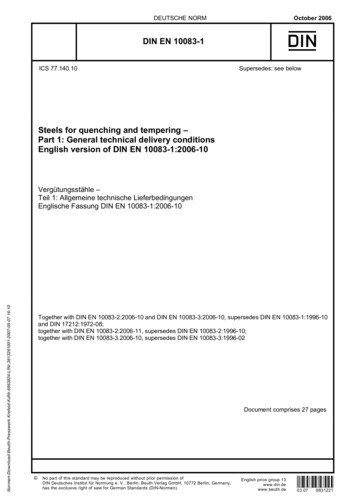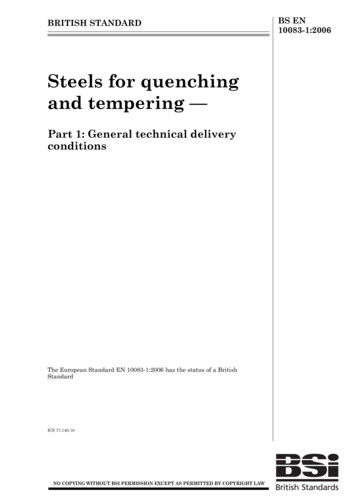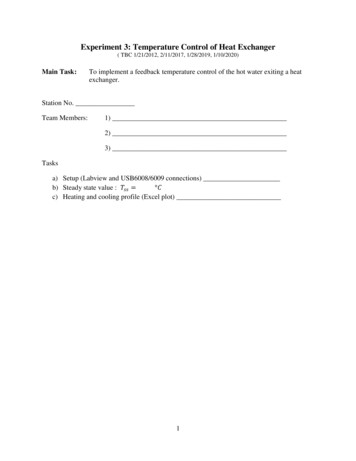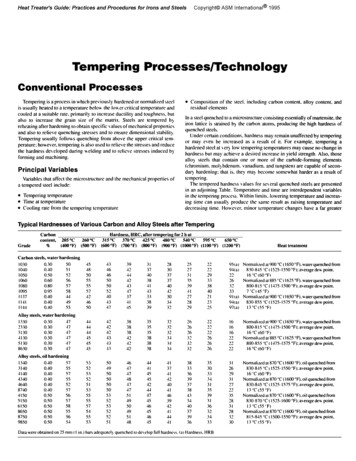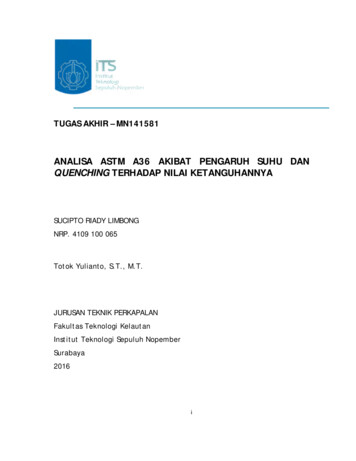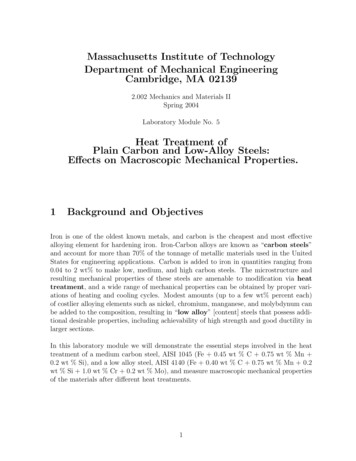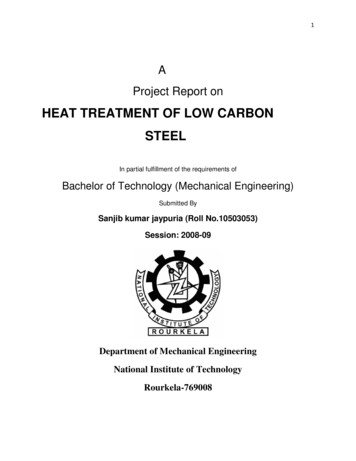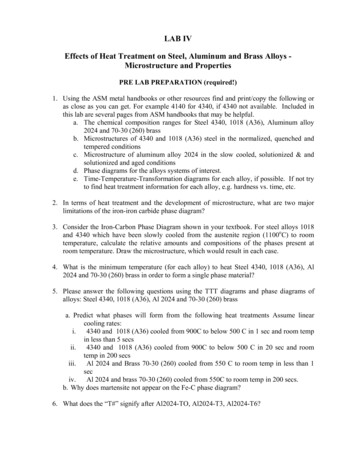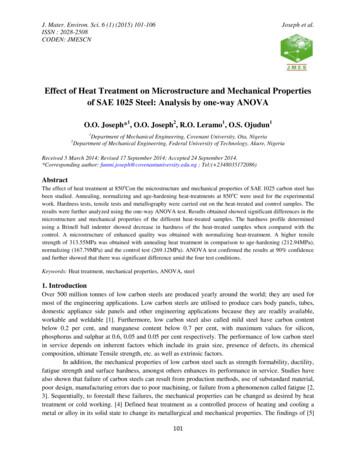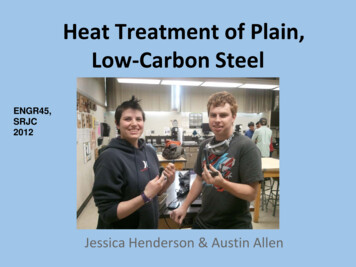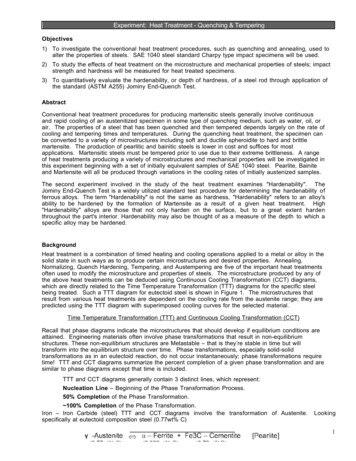
Transcription
Experiment: Heat Treatment - Quenching & TemperingObjectives1) To investigate the conventional heat treatment procedures, such as quenching and annealing, used toalter the properties of steels. SAE 1040 steel standard Charpy type impact specimens will be used.2) To study the effects of heat treatment on the microstructure and mechanical properties of steels; impactstrength and hardness will be measured for heat treated specimens.3) To quantitatively evaluate the hardenability, or depth of hardness, of a steel rod through application ofthe standard (ASTM A255) Jominy End-Quench Test.AbstractConventional heat treatment procedures for producing martensitic steels generally involve continuousand rapid cooling of an austenitized specimen in some type of quenching medium, such as water, oil, orair. The properties of a steel that has been quenched and then tempered depends largely on the rate ofcooling and tempering times and temperatures. During the quenching heat treatment, the specimen canbe converted to a variety of microstructures including soft and ductile spheroidite to hard and brittlemartensite. The production of pearlitic and bainitic steels is lower in cost and suffices for mostapplications. Martensitic steels must be tempered prior to use due to their extreme brittleness. A rangeof heat treatments producing a variety of microstructures and mechanical properties will be investigated inthis experiment beginning with a set of initially equivalent samples of SAE 1040 steel. Pearlite, Bainiteand Martensite will all be produced through variations in the cooling rates of initially austenized samples.The second experiment involved in the study of the heat treatment examines "Hardenability". TheJominy End-Quench Test is a widely utilized standard test procedure for determining the hardenability offerrous alloys. The term "Hardenability" is not the same as hardness, "Hardenability" refers to an alloy'sability to be hardened by the formation of Martensite as a result of a given heat treatment. High"Hardenability" alloys are those that not only harden on the surface, but to a great extent hardenthroughout the part's interior. Hardenability may also be thought of as a measure of the depth to which aspecific alloy may be hardened.BackgroundHeat treatment is a combination of timed heating and cooling operations applied to a metal or alloy in thesolid state in such ways as to produce certain microstructures and desired properties. Annealing,Normalizing, Quench Hardening, Tempering, and Austempering are five of the important heat treatmentsoften used to modify the microstructure and properties of steels. The microstructure produced by any ofthe above heat treatments can be deduced using Continuous Cooling Transformation (CCT) diagrams,which are directly related to the Time Temperature Transformation (TTT) diagrams for the specific steelbeing treated. Such a TTT diagram for eutectoid steel is shown in Figure 1. The microstructures thatresult from various heat treatments are dependent on the cooling rate from the austenite range; they arepredicted using the TTT diagram with superimposed cooling curves for the selected material.Time Temperature Transformation (TTT) and Continuous Cooling Transformation (CCT)Recall that phase diagrams indicate the microstructures that should develop if equilibrium conditions areattained. Engineering materials often involve phase transformations that result in non-equilibriumstructures. These non-equilibrium structures are Metastable – that is they’re stable in time but willtransform into the equilibrium structure over time. Phase transformations, especially solid-solidtransformations as in an eutectoid reaction, do not occur instantaneously; phase transformations requiretime! TTT and CCT diagrams summarize the percent completion of a given phase transformation and aresimilar to phase diagrams except that time is included.TTT and CCT diagrams generally contain 3 distinct lines, which represent:Nucleation Line – Beginning of the Phase Transformation Process.50% Completion of the Phase Transformation. 100% Completion of the Phase Transformation.Iron – Iron Carbide (steel) TTT and CCT diagrams involve the transformation of Austenite.specifically at eutectoid composition steel (0.77wt% C)Looking1ME 3701, Materials of Engineering Laboratory, LSU
Pearlite is composed of alternating layers of Ferrite and Cementite. Pearlite layer thickness is a function ofquenching temperature (and Rate):01. Thick layers (Coarse Pearlite) are produced at a quench temperature of 650 C.02. Thin layers (Fine Pearlite) are produced at a quench temperature of 500 C.3. A particulate structure (Bainite) is produced at a quench temperature of 3500C.Coarse Pearlite is relatively soft and ductile but is often utilized as a low-cost structural material. Its'properties depend largely on carbon content. Fine Pearlite is generally a mid-range steel with goodstrength and ductility characteristics; actual properties are a function of carbon content. Bainite isstronger and slightly less ductile than Fine Pearlite. Overall Bainite is a relatively cheap steel whichcombines good strength with moderate ductility.If Austenite is quenched (cooled rapidly) at a rate such that the knee of the TTT/CCT diagram is avoided(rapid quench), a diffusionless transformation into Martensite occurs where:MS - Start of the Transformation.M50 - 50% Transformed into Martinsite.M90 - 90% Transformed into Martinsite.The Martensite transformation involves sudden reorientation of the carbon atoms in the FCC Austenitestructure to a Body Centered Tetragonal (BCT) structure without allowing time for the diffusion of atomsto their lowest-energy equilibrium positions. The result is a high internal energy material that is verystrong, hard, brittle and susceptible to rapid crack growth.Figure 1 - TTT Diagram for Eutectoid Steel.[Shackelford, 1996]Continuous Cooling Transformation (CCT) Diagrams2ME 3701, Materials of Engineering Laboratory, LSU
Figure 2 - CCT Diagram for a Eutectoid Steel.[Callister, 1991]In practice, most heat treatments forsteels involve the continuous coolingof a specimen to room temperature.TTT diagrams are valid only forconstant quenching temperatures. ForContinuous Cooling, the required timefor a reaction to begin and end isslightly delayed and cooling does notoccur at a constant temperature.Hardness TestingHardness tests measure the resistance to penetration of the surface of a material by a hard object. Thedepth of penetration is measured by the testing machine and converted to a hardness number. C-ScaleRockwell Hardness (HRC) numbers can be converted to Brinell Hardness (HB) numbers and then used toapproximate the tensile strength in steels.Impact TestingWhen a material is subjected to a sudden intense blow in which the strain rate is extremely rapid, it maybehave in a much more brittle manner than is observed in the tensile test. The Charpy Impact test, alsoknown as the notch toughness test, is often used to evaluate the brittleness of a material under theseconditions. The test specimen should be notched, because V-notched specimens better measure theresistance of the material to crack propagation. The ability of a material to withstand an impact blow is oftenreferred to as the toughness.Hardenability: Jominy End-Quench TestHardenability refers to the relative ability of a steel to be hardened by the formation of martensite. Thecurves shown in Figure 3 are Hardenability Curves produced from Jominy End Quench Tests where water issprayed on the end of a heated steel bar. Note the following: the 5140 steel is only hard near the quenched end (low hardenability) the 4340 steel is relatively hard all along the bar (high hardenability)3ME 3701, Materials of Engineering Laboratory, LSU
Figure 3 - Hardenability Curves for some Common Alloy Steels. [Shackelford, 1996]Figure 4 - Specimen and Fixture for a Jominy End-Quench Hardenability Test. [Shackelford, 1986]The Jominy End-Quench test consists of selectively cooling a standard size bar of steel, as is illustrated inFigure 4. The specimen consists of a cylindrical bar with a 1-in. diameter and 4-in. length. After the samplehas been austenized, it is placed in a fixture, as shown in Figure 4, and a jet of water is quickly splashedonto one end of the specimen. Note that only the end of the specimen is actually quenched, and as aresult, the transformation of Austenite begins at the water-cooled end and progresses "up" the bar. Thecooling rate decreases with increasing distance from the quenched end and thus microstructure and materialproperties are functions of the distance from the quenched end. After cooling, a flat surface is ground onthe test bar and Rockwell C hardness measurements are made along the surface up to 3 inches from thequenched end. The results are plotted in the form illustrated in Figure 3 that indicates the hardenability of agiven steel.Note the Following:-There is a rapid decrease in the hardness of steels with relatively low hardenability as a function of thedistance from the water quenched end.-There is a gradual decrease in the hardness of steels with relatively high hardenability as a function ofthe distance from the water quenched end.4ME 3701, Materials of Engineering Laboratory, LSU
For steel, ultimate strength is related to Rockwell C hardness and thus the strength of a heat-treated steelcan be approximated from the Rockwell C hardness values. Figure 5 presents a conversion for Brinell,Vickers and Rockwell tests.Figureand Ultimate Tensile Strength for Steel Parts.[Metals Handbook - Desk Edition, 1992]5 - Relationships Between HardnessExperimental Procedure1.Immerse five SAE 1040 specimens (and the Jominy Bar) in charcoal powder contained in a ceramiccrucible. Austenitize these at 900oC for 1 hour. Allow adequate time for the crucible to heat to thetemperature of the furnace (about 10 minutes). A total of 1 hour heating time should be adequateallowing roughly 45-50 minutes of soaking.2.Normalizing - Rapidly remove one specimen and allow it to cool in air on a ceramic base.3.Quench Hardening – Rapidly remove two specimens and quench them in water at roomtemperature.4.Tempering – Reheat one of the water quenched specimens to 400oC in another furnace for 30minutes, then remove it and allow it to cool in air to room temperature.5.Austempering – Remove one specimen and quench it in a fused salt bath (mixture of Na-nitrate andNa-Nitrite in equal proportion) that is maintained at 400oC. Hold the quenched specimen in the saltbath inside the furnace for 30 minutes then remove it and quench it in water or allow it to air cool toroom temperature.6.Annealing – Allow the fifth specimen to cool in the furnace itself after switching the power to thefurnace off. When the temperature of the furnace drops to between 650 - 600 C, remove thespecimen and quench it in water at room temperature or allow the furnace to cool down slowly toroom temperature and remove the specimen thereafter.5ME 3701, Materials of Engineering Laboratory, LSU
7.Develop a Data Sheet that includes the following:a. Determine the Rockwell hardness values for each of the heat treatedspecimens after cleaning one of the surfaces with sand paper to remove anyhard carbon deposits that may have formed on the surface. Take 5 readingson each sample.b. Determine the Charpy impact strengths of all the heat treated specimens(make sure the Impact Testing Machine is rezeroed after each test!).c. Examine the fracture surfaces of each specimen and note the salientfeatures.Hardenabilty: Jominy End-QuenchApparatus1.2.3.4.5.6.7.8.High Temperature Oven (Capable of up to 1000oC)Controllable Flow Water Source of Room Temperature (24oC) WaterStandard 4-Inch Jominy Test Bar with Appropriate Mounting FixtureHeat Resistant GlovesHeat Resistant Face-MaskOven Tongs for Removal of the Jominy Test Bar from the OvenMetallographic Grinding EquipmentHardness Tester (Rockwell Type)Procedure1.Preheat the oven to 1500 F (816 C).2.Check that the Jominy Test Set-Up tank is full of room-temperature water.3.Adjust the water spout height on the Jominy Test Set-Up to 2 and 1/2 inches above the final restingposition of the Test-Bar bottom when placed in the specimen fixture.4.Properly place the specimen fixture directly over the water spout of the Jominy Test Set-Up with thefixture center placed directly above the water spout center. Practice rapidly placing a cool sample intothe fixture before proceeding.5.Remove the Jominy Sample from the oven with the oven tongs and place it in the Jominy Fixture asquickly as possible.6.Let the Test Bar cool to room temperature (approximately 20 to 30 minutes) then turn off the water.7.Each group of 2-3 students must check out the lab session’s Jominy Test Bar from the lab instructorand grind a flat onto the curved surface of the lab session’s Jominy Test Bar. All Scale (oxide) on theflat should be removed such that a shinny, smooth flat results. Try to remove the minimal amount ofmaterial to obtain a shinny flat!8.Using a pencil, clearly mark the positions along the bar on the ground flat at the distances from theTest Bar End as indicated on the blank Jominy End-Quench Data Sheet.9.Take a single set of Rockwell C hardness measurements along the bar on the ground flat at thedistances marked in Step 8; record the values on the data sheet.10. Return the Jominy Test Bar to the lab instructor.6ME 3701, Materials of Engineering Laboratory, LSU
Jominy End-Quench Data SheetSpecimen Description:Date & Time:Rockwell Scale and 2122Data Collected By:Spacing fromPrecedingMeasurement(in.)Distance fromQuenched /81/811/81 & 1/81/81& 2/81/81& 3/81/81& 4/81/41& 6/81/421/42 & 1/41/42 &2/41/42 & 3/41/437ME 3701, Materials of Engineering Laboratory, LSU
Lab Requirements- QuenchingF
Experiment: Heat Treatment - Quenching & Tempering Objectives 1) To investigate the conventional heat treatment procedures, such as quenching and annealing, used to alter the properties of steels. SAE 1040 steel standard Charpy type impact specimens will be used. 2) To study the effects of heat treatment on the microstructure and mechanical properties of steels; impact strength and hardness .
